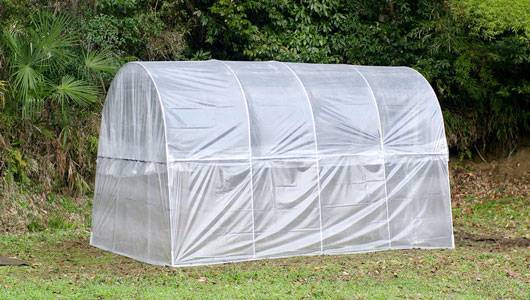
A greenhouse does not have to be an expensive permanent structure, designed for year-long use. If you only need a greenhouse at certain times of the year, or it is cost prohibitive to purchase a permanent greenhouse, a temporary greenhouse may be a good solution.
Tunnel or hoop houses are one type of temporary greenhouse that is commonly used by hobby growers. These seasonal greenhouses consist of a transparent plastic covering stretched over a frame of PVC, aluminum, wood or steel. They can be installed in a few hours and do not require a foundation. Plastic films that can last up to 5 years are available for the cover. It is easy to make a tunnel greenhouse to fit a single raised bed, or to cover a specific area.
The disadvantages of a hoop house are the poor insulation and ventilation. It is possible to add a second layer of plastic and pump air between the two to add some insulation. Ventilation is achieved by rolling up the sides during hot weather, or leaving the ends open. However, in spring and fall, as the sun heats the air inside, these greenhouses work quite efficiently.
Tunnel or hoop houses can be used to extend the growing season. They can serve as an intermediate stage for preparing plants for the garden. Seeds started indoors can be transferred to the hoop house to give them a head start. The benefit of sunlight helps the plants grow with greater energy in a hoop house than they than they would if they remained indoors.
When warm weather arrives, the sides of the hoop house covering can be rolled up for ventilation and heat control or even removed completely. When fall arrives, the covering can be replaced and the plants placed inside for protection during the cooler nights.
Heat loving vegetables like tomatoes, cucumbers, peppers and melons can be planted directly in a raised bed with a hoop or tunnel greenhouse set over it. The cover can be raised in hot weather so air can circulate and plants can take advantage of rain. Then, as fall arrives and the weather cools, the cover can be replaced so the crops continue to grow and mature well into the season.
Seasonal or temporary greenhouses can also be used to protect plants of borderline hardiness in the winter. The temperature under the plastic cover is usually a few degrees warmer than the outside air, and the cover also reduces the drying and chilling effect of wind. As plants inside the seasonal greenhouse become dormant, they can be covered with mulch to protect them even further from the outside cold.
Related Articles
Artificial Light for the Greenhouse




Comment here